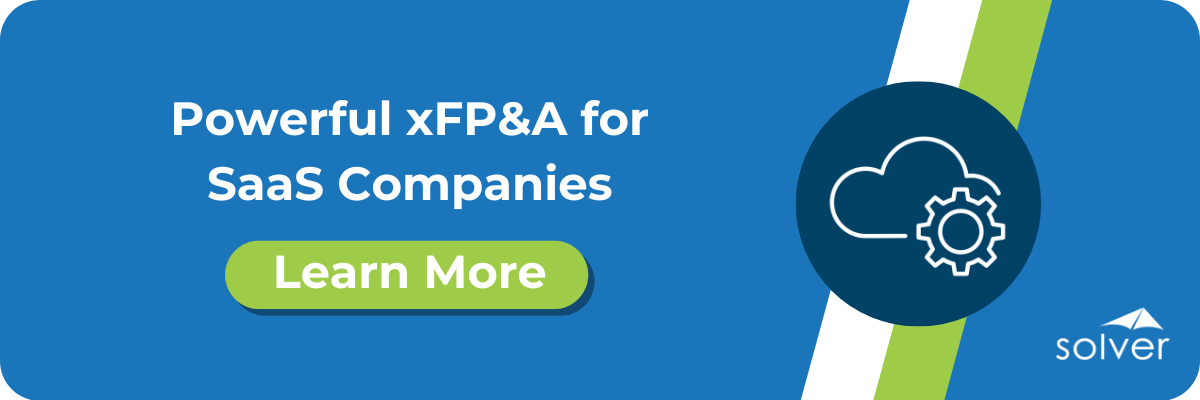Related Posts
SaaS Product Scaling: Challenges and Solutions

The need to scale is a sign of success. But with increasing size comes increasing complexity. As a SaaS business grows, when working with an ever-lengthening client list and perhaps offering a wider array of features and subscription tiers, the company’s finances grow more complex to monitor and analyze. Things get exponentially more complicated when a company grows to the point that it’s dealing with mergers and acquisitions (M&As), overseeing subsidiaries, and/or operating in multiple countries.
Under these conditions, details can too easily slip through the cracks, a dangerous prospect when compliance is at stake. Strategic decision-making can begin to feel paralyzingly hard.
That’s why extended financial planning and analysis (xFP&A) solutions are so crucial for growing SaaS companies. These tools allow companies to manage their data, condensing an overwhelming amount of information into a single source of truth that can be used to steer the business forward. While xFP&A solutions offer numerous benefits to their users, consolidation is among the most important for SaaS providers.
Financial consolidation is an essential process for large companies with multiple entities, subsidiaries, or international operations. Here’s why.
Why SaaS Consolidation Can Be Game-Changing
When SaaS providers grow, they often grow fast and globally.
A company that has been through any kind of merger or acquisition and has multiple subsidiaries, perhaps across borders, may feel like it’s working with a jumble of puzzle pieces that don’t quite fit together. Each organization under the parent company’s umbrella likely had its own ERP, chart of accounts, software language, and regulatory and compliance standards previously. If the company operates internationally, different locations and subsidiaries likely transact in multiple currencies as well.
When all those disparate pieces come together, it’s often up to the CFO and other financial executives to square the discrepancies. This is no easy feat, since SaaS M&A finance can be mind-bendingly complex when handled manually.
xFP&A solutions handle the most labor-intensive and error-prone parts of the process, including IFRS to GAAP adjustments, currency conversions, and intercompany eliminations, so the company’s team doesn’t have to. Fiscal calendars need not be aligned nor ERPs reassigned, and businesses avoid the need to reconcile and manage a never-ending stream of spreadsheets. Plus, new subsidiaries can easily join the roster post-acquisition.
When xFP&A is used for SaaS consolidation, core processes are automated and streamlined to free up time, boost productivity, and reduce the likelihood of costly mistakes. Even international financial reporting, typically a highly laborious process, becomes simple.
xFP&A software allows organizations to consolidate all essential financial data in one place, where it’s easy to access, understand, and use for business-critical decision-making. Make no mistake, though; just because data is centralized doesn’t mean segment-level reporting is impossible.
Quite the contrary. Financial Planning and Analysis solutions, users can go beyond the top-line numbers to understand financial performance and other key performance indicators (KPIs) on a location or subsidiary level. The ability to drill down into specific data points further enhances insights by allowing users to examine the transactions and assumptions underlying the boldface numbers and track data back to its source. This enables deeper insights into the drivers behind performance and allows stakeholders to answer questions on the fly for quick, data-driven decision-making.
The Downstream Benefits of SaaS Consolidation
It’s easy to see why CFOs and other financial executives benefit from consolidation. After all, they’d be the ones struggling to put together that mess of puzzle pieces manually. Working with one consolidated and comprehensive data source is far easier than reconciling multiple, potentially non-compatible information streams.
But SaaS stakeholders must understand that the entire organization stands to benefit from xFP&A solutions like Solver for SaaS. When a multi-entity business’ data is harmonized and available in one place, decision-makers gain access to an unprecedented level of clarity, with the ability to streamline international financial reporting, run modeling scenarios (including future M&As and international expansions), track trends and KPIs, and accurately forecast for the future. With those abilities comes the power to make decisions that will benefit the entire organization as a whole—far preferable compared to making scattershot choices based on siloed and incomplete data.
Similar benefits trickle down well past the executive office. With xFP&A, employees across an organization can use consolidated data to better monitor and understand a wide range of financial and operational KPIs, and then create relevant reports. This ability ensures that stakeholders at every level of an organization can access the data they need, in a format that is most useful for their specific roles and responsibilities. Report filtering capabilities allow users to slice and dice data based on specific parameters, making it easier to analyze financial performance from different angles to enhance the decision-making process.
Knowledge is power. So why should that knowledge be limited to the financial department?
With xFP&A, it doesn’t have to be. Your SaaS business has already done the hard work of building an exceptional product, then expanding that product’s reach by scaling the company. Make the next phase of your company’s journey easier. Solver for SaaS will harness the power of your data through consolidation, creating a single source of truth that can help your business reach new heights.
Want to learn more? Connect with one of our industry experts to automate your xFP&A processes today.
TAGS: Thought Leadership, xFP&A, SaaS
Global Headquarters
Solver, Inc.
Phone: +1 (310) 691-5300

